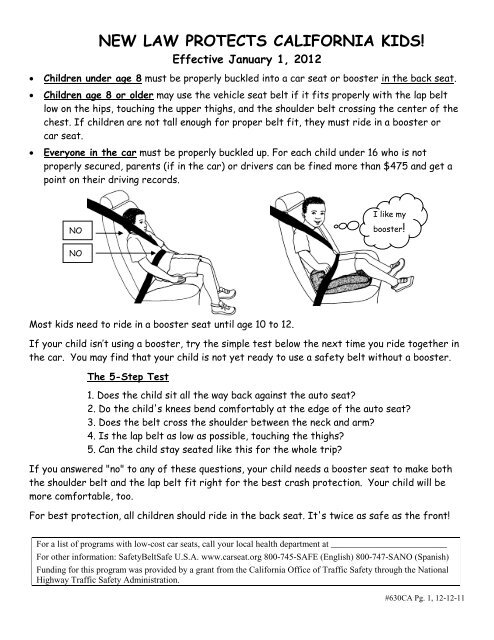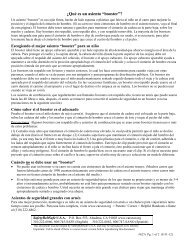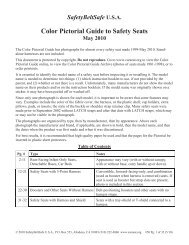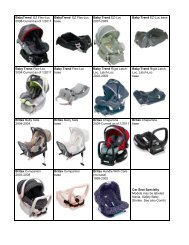New law protects california kids! - SafetyBeltSafe USA
New law protects california kids! - SafetyBeltSafe USA
New law protects california kids! - SafetyBeltSafe USA
Create successful ePaper yourself
Turn your PDF publications into a flip-book with our unique Google optimized e-Paper software.
NEW LAW PROTECTS CALIFORNIA KIDS!<br />
Effective January 1, 2012<br />
Children under age 8 must be properly buckled into a car seat or booster in the back seat.<br />
Children age 8 or older may use the vehicle seat belt if it fits properly with the lap belt<br />
low on the hips, touching the upper thighs, and the shoulder belt crossing the center of the<br />
chest. If children are not tall enough for proper belt fit, they must ride in a booster or<br />
car seat.<br />
Everyone in the car must be properly buckled up. For each child under 16 who is not<br />
properly secured, parents (if in the car) or drivers can be fined more than $475 and get a<br />
point on their driving records.<br />
NO<br />
NO<br />
Most <strong>kids</strong> need to ride in a booster seat until age 10 to 12.<br />
If your child isn’t using a booster, try the simple test below the next time you ride together in<br />
the car. You may find that your child is not yet ready to use a safety belt without a booster.<br />
The 5-Step Test<br />
I like my<br />
booster!<br />
1. Does the child sit all the way back against the auto seat?<br />
2. Do the child's knees bend comfortably at the edge of the auto seat?<br />
3. Does the belt cross the shoulder between the neck and arm?<br />
4. Is the lap belt as low as possible, touching the thighs?<br />
5. Can the child stay seated like this for the whole trip?<br />
If you answered "no" to any of these questions, your child needs a booster seat to make both<br />
the shoulder belt and the lap belt fit right for the best crash protection. Your child will be<br />
more comfortable, too.<br />
For best protection, all children should ride in the back seat. It's twice as safe as the front!<br />
For a list of programs with low-cost car seats, call your local health department at __________________________<br />
For other information: <strong>SafetyBeltSafe</strong> U.S.A. www.carseat.org 800-745-SAFE (English) 800-747-SANO (Spanish)<br />
Funding for this program was provided by a grant from the California Office of Traffic Safety through the National<br />
Highway Traffic Safety Administration.<br />
#630CA Pg. 1, 12-12-11
California Buckle-Up Laws for Parents<br />
Car crashes are the #1 preventable cause of death of children and young adults, as well as a major cause of permanent<br />
brain damage, epilepsy, and spinal cord injuries. A sudden stop at 30 miles per hour could cause the same crushing force<br />
on your child's brain and body as a fall from a three-story building. Fortunately, by buckling up children, we can prevent<br />
most of these deaths and serious injuries.<br />
(V.C. 27360) All children under age 8 must be properly buckled into a safety seat or booster in the back seat.<br />
Exceptions: A child who weighs more than 40 pounds and is riding in a car without lap and shoulder belts in the back<br />
seat may wear just a lap belt. A child under age 8 who is at least 4'9" may wear a safety belt if it fits properly. Children<br />
under age 8 may ride in the front if there is no forward-facing rear seat in the vehicle, the child restraint cannot be<br />
properly installed in rear seat, all rear seats are occupied by other children age 7 or under, or for medical reasons. A child<br />
in a rear-facing safety seat may not ride in front if there is an active passenger air bag.<br />
(V.C. 27360.5) Children age 8 or over may use the vehicle safety belt if it fits properly with the lap belt low on the hips,<br />
touching the upper thighs, and the shoulder belt crossing the center of the chest. If children are not tall enough for proper<br />
belt fit, they must ride in a booster or safety seat.<br />
Consequences for failing to properly buckle up any child under 16<br />
The parent gets the ticket if a child under 16 is not properly buckled up.<br />
The driver gets the ticket if the parent is not in the car.<br />
The cost of a ticket could be more than $475* per child; the fine for a second offense could be more than<br />
$1000* per child. One point is added to the driving record, which could raise insurance rates. Part of the<br />
fine money goes to a special fund to help pay for local safety seat education and distribution programs.<br />
Related Information<br />
Older babies and toddlers should ride in a rear-facing convertible seat until they are at least two years old. Check<br />
manufacturer’s instructions for the maximum weight (30-45 lbs.).<br />
Children should ride in a safety seat with a harness as long as possible (40-90 lbs., depending on the model).<br />
Children who have outgrown their safety seats need a booster for proper belt fit (usually until age 10-12). To find<br />
out if a child is tall enough to wear just a safety belt, try the 5-Step Test, available from <strong>SafetyBeltSafe</strong> U.S.A.<br />
Auto insurers are required to replace safety seats that were in use or damaged during a crash.<br />
(V.C. 27315) Drivers and passengers 16 or older must be properly buckled up in vehicle safety belts.<br />
The driver may be ticketed for not wearing a belt and for each unbuckled passenger. Fine is more than $140* per person.<br />
Passengers also may be ticketed for not being properly buckled up.<br />
(V.C. 23116) Pickup truck passengers also must be properly buckled up.<br />
The driver may be ticketed for letting passengers ride in the back of a pickup truck.<br />
Passengers also may be ticketed for not being properly buckled up.<br />
The cost of a ticket could be more than $200* for each unbuckled adult. No exemption for camper shells.<br />
Other Laws to Protect Children<br />
Children left in vehicle (V.C. 15620): A child 6 years old or less may not be left alone in a vehicle if the health<br />
or safety of the child is at risk, the engine is running, or the keys are in the ignition. The child must be supervised<br />
by someone at least age 12. The cost of a ticket could be more than $475.*<br />
Smoking in a vehicle [Health and Safety Code 118948(a)] is prohibited if a child under 18 is present. The cost<br />
of a ticket could be more than $475.*<br />
Helmets (V.C. 21212, 21204, 27803): Children under age 18 who are skating or riding on a bicycle, scooter, or<br />
skateboard must wear a properly fitted and fastened helmet. All drivers and passengers on a motorcycle must<br />
wear a helmet that meets federal standards, fits correctly, and has the proper label.<br />
* Fine amounts shown include penalty assessments<br />
<strong>SafetyBeltSafe</strong> U.S.A. P.O. Box 553, Altadena, CA 91003 www.carseat.org (800) 745-SAFE<br />
This document was developed by <strong>SafetyBeltSafe</strong> U.S.A. and may be reproduced in its entirety.<br />
Important: Call to check if there is a more recent version before reproducing this document.<br />
#630CA Pg. 2, 12-12-11






